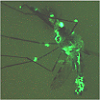One Step Closer to Cows Without The Gas
Published on Sunday, January 31st, 2010 at 7:30 pm
The first map of a rumen methanogen DNA sequence as created by researchers at
PGgRC was published in the journal PLoS One, giving scientists worldwide a major new opportunity to identify methods for cutting methane emissions from cows. Rumen methanogens are the bacteria responsible for the methane produced by livestock. The bacteria ? of which there are a number of species ? live in the gut of ruminant livestock, removing the hydrogen and carbon dioxide released as grass and other plant materials are broken down. The byproduct of this process, however, is large amounts of methane: one of the most potent greenhouse gases known.
The objective behind sequencing a rumen methanogen ? in this case Methanobrevibacter ruminantium, a bacterium with 2200 genes and almost 3 million basepairs ? is to figure out how to selectively knock them out in ways which will not damage other, beneficial bacteria. Possible approaches are vaccines, drenches or even changing forage.
The PGgRC estimates it will still be a few years until any practical means of reducing methane can be developed.
[Via PGgRC]
Popular Science has been a leading source of science, technology and gadget news since 1872. With up-to-the minute latest space news, insightful commentary on the new innovations and concept cars ...if it's new or future technology you'll find it at popsci.com.au.
WW Media - Popular Science © 2010
Cameras - Home Entertainment - Mobile Phones
This entry was posted
on Sunday, January 31st, 2010 at 7:30 pm and is filed under Animals, Science.
You can follow any responses to this entry through the RSS 2.0 feed.






